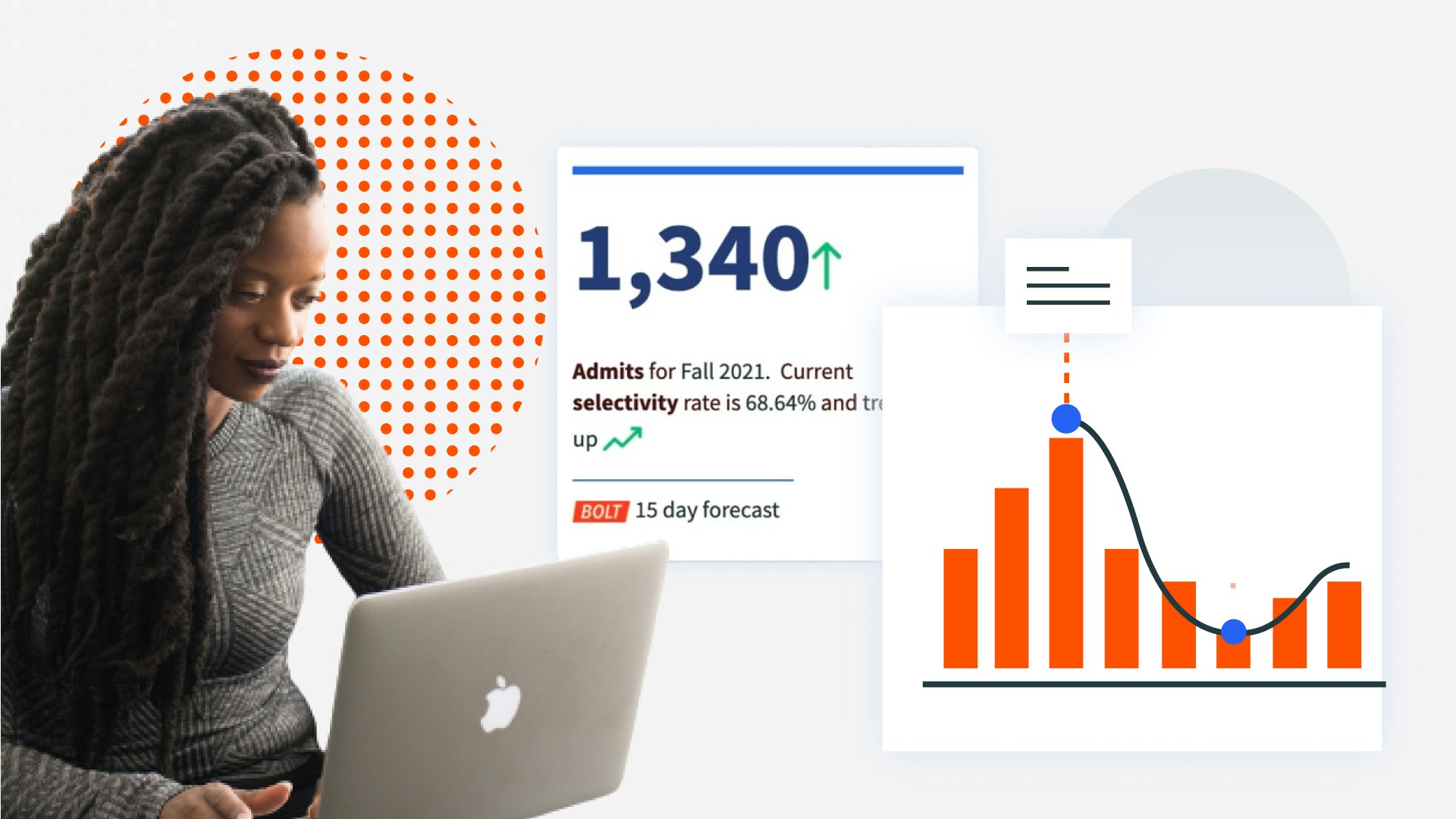The Silent Killer in Higher Education Enrollment: Student Retention
by Sirley Carballo · Updated Sep 13, 2024
In the realm of higher education, we spend a great deal of time and attention focusing on getting students in the door. This is, after all, the way that the college funnel works. Recruitment, admissions, and enrollment are the keys to filling classes and keeping the wheels of higher ed turning.
Unfortunately, it’s possible to spend so much time and effort on the earliest aspects of the story that we sometimes neglect the later chapters. What happens once college students have been enrolled? How do struggling students stay engaged in the campus community? Is the student body successful in reaching its collective goals?

Retention strategies must become a high priority for any college or university that has ambitions to grow and attract more students. If you want to increase student retention this year, keep reading to learn which factors affect retention and how to better support students.
What is Student Retention?
Student retention is the number (usually expressed as a rate) of students who enroll and stay enrolled through degree attainment. Some colleges and universities might refer to this number as student persistence, but its meaning is the same.
Schools with great retention strategies often have the right programs, policies, and support in place to assist students in achieving what they set out to do upon admission or enrollment.
What Are the Problems with Student Retention?
Student retention rates can be influenced by a number of different factors. While some of these are institutional (meaning that they stem from specific actions the school does or does not take), others are personal in nature.
Regardless, high levels of student retention often reflect an institution’s commitment to providing support and helping students succeed. Schools that fail to do this effectively often have students who struggle with the following problems and scenarios.
- Poor performance and lackluster academic skills
- Low involvement in the campus community
- Inability to access helpful or timely campus resources
- Financial struggles
- Low attendance, including drop-outs in specific courses
- Negative perceptions or attitudes about schooling in general
Higher Education Persistence
Retention rates vary by college or university. Within the broader campus community, certain programs or student sub-groups may have their own retention rates. Administration and campus leaders may review or use these numbers to make decisions about future support.
Retention rates are also measured and studied based on the degree programs and length of degree program. For example, four-year institutions sometimes experience lower retention rates due to the length of the program and nature of the longer commitment.
According to the National Student Clearinghouse Research Center, there was an overall persistence rate of 75.0% nationally beginning in 2020. This is a very small increase from previous years.
Top Factors that Affect Retention and Student Experiences
Every college student that you interact with has their own unique student experience. While no two student journeys look the same, admissions leaders can be more mindful of the many factors that influence a student’s decision to stay enrolled. When these factors are brought to light early on, it’s easier to have a deeper understanding and positive influence.
In the list below, we’ll share some of the most prominent reasons why students choose not to persist. Equipped with this information, your campus team will be ready to provide support services to students lacking the right tools for their education.
Financial Stress
Financial factors play a considerable role in many students’ long-term choices. Whether it’s juggling scholarships, federal financial aid, private loans, or even out-of-pocket costs, the path to a college degree can be expensive.
In many cases, individual students face major financial decisions more often than just once every year. These choices (and pressures) often occur every semester when it’s time to choose new classes, pay applicable fees, purchase books or materials, and take care of living costs.
For some students, enrollment is a choice between pursuing a degree or staying financially afloat. Lack of support or access to financial resources can contribute to overall retention problems.
Lack of Academic Support and Available Resources
In order to achieve educational goals, students must do their part and take ownership of their academics. While this is always true, access to the right resources and academic support can make that process less stressful.
When students have limited access to academic resources (including libraries, tutoring opportunities, office hours, or advising teams), staying ahead of the curve can become much more challenging. Although this depends on the individual student, most college communities benefit from investing in rich academic resources that improve study skills.
Students also need basic skills to continue persisting in their college careers. This includes writing, verbal communication, social skills, critical thinking, and logic. When support for these critical skills is not easily accessible, students often have a more difficult time.

Get A Demo of Element451
Students explore and pick where they’ll earn a degree in completely new ways and the old way of recruiting just won't cut it. Step into the new world of enrollment, powered by Element451. We've been waiting for you.
See It in Action
Difficulties in Online or Hybrid Environments
Online and hybrid environments may offer tremendous flexibility to modern learners. There is, however, a flip side to relying on online or hybrid learning platforms for students who may excel in an in-person environment.
Students who take online courses but enjoy the in-person engagement of a traditional classroom or campus life could struggle to feel connected to the learning process. As a result, it’s easier to be distracted, lose focus, or even fail to do the required work.
When colleges or universities begin to replace in-person classes with virtual options, it’s wise to provide adequate and comparable support resources to help compensate. These efforts could prevent well-meaning students from disembarking on their journey to a degree too soon.
Personal Factors
Student retention is an important responsibility and priority for colleges, but students themselves have a role to play. Some personal factors, such as mindset, attitude, or even a lack of professional ethics within a college environment can influence how long a student stays enrolled.
While some personal factors are intrinsic, others might be external. Students who experience major life events, health issues, or problems with family responsibilities may struggle in an academic context. Having the right support (including mental health counseling and early intervention specialists) can help students navigate difficult times despite their challenges.
This is also when it becomes helpful to view the student as a whole individual, rather than as simply a number in the potential graduation line. Remembering conversations, logging interactions, and providing resources along the way can improve a student’s standing.
Student Retention Software Options
Despite very diligent efforts, all schools will have students who disenroll or leave school. This is simply the nature of higher education, in which eventual degree attainment depends on a certain level of commitment and willingness to see it through.
On the bright side, providing helpful and practical interventions is becoming easier with the help of student retention software options. These tools make it easier to understand the student lifecycle, pinpoint specific student needs, and redirect students when necessary.
For example, some schools are turning to predictive analytics software to anticipate major events that impact a student’s ability to persist. Retention software is often designed to improve communication between important parties in a student’s journey, from faculty and administrators, to support staff, to other important members of the community.
Benefits of Student Retention Software
Higher education retention software can be one part of your school’s comprehensive enrollment and retention puzzle. This is because retention software offers the ability to:
- Predict important trends
- Identify red flags along the path to degree attainment
- Empower schools to reach out with the right resources
- Provide intervention strategies in time to make a difference
Enhance Student Retention with Personalization
Student retention doesn’t just start when a student is identified as needing help. To truly retain students, colleges and universities must first understand who students are and what they need. This is where personalization comes into play.
Personalization can help build a foundation for long-term retention. When students grow accustomed to personalized messaging, they’re likely to feel more invested in the school community at large. They may also have a better idea of who to contact for help, which resources are most valuable, and where to turn when big questions pop up.
By leveraging personalized student engagement strategies, schools can also make better choices when it comes to offering admissions opportunities. When enrollment officers have a holistic understanding about each student, it may be easier to predict which students will perform well in a particular environment, and which students would be better suited to another school or academic offering.

The Guide to Gen-Z and Content Personalization
Gen-Z expects brands to communicate with them like they know who they are. Why should colleges and universities be an exception? Our personalization guide will show you how to cut through the noise and truly engage today's students.
Download the White Paper
Improve Student Retention Today
College and university students begin to make decisions about their college persistence from early on. This means that experiences along the student journey add up over time. From basic interactions to seemingly small exchanges, student satisfaction depends on being seen, heard, and understood.
Believe it or not — the tools and technology you use to manage the student lifecycle can make a difference at the beginning, middle, and end of a student’s journey. It’s more important than ever to focus on how you can help improve that relationship by improving retention strategies.
Book your Element451 demo today to see how personalized student engagement can revamp your full funnel student marketing efforts and in turn, improve student retention rates.

About Element451
Boost enrollment, improve engagement, and support students with an AI workforce built for higher ed. Element451 makes personalization scalable and success repeatable.
Categories
New Blog Posts

The Definitive Guide
AI in Higher Education
Bridge the gap between the latest tech advancements and your institution's success.
Useful Links
Related Articles

Talk With Us
Element451 is the only AI Workforce Platform for higher education. Our friendly experts are here to help you explore how Element451 can improve outcomes for your school.
Get a Demo








